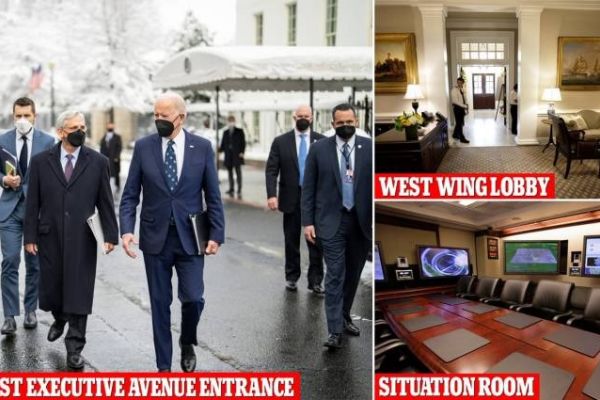In the heart of the White House, behind closed doors and beneath the corridors of power, lies a space that has witnessed some of the most critical moments in American history. The Situation Room, a highly secure and specially wired complex of rooms, has recently undergone a stunning transformation. Join us as we take an in-depth look at the revamped Situation Room and the intriguing backdrop of a small cocaine discovery that preceded its grand reveal.
Situation Room
Page Contents
- 1 Situation Room
- 1.1 The Presidential Ribbon Cutting
- 1.2 Aesthetic Transformation
- 1.3 The Reworked Conference Room
- 1.4 The Operations Center
- 1.5 A Secure Location
- 1.6 Addressing a Controversy
- 1.7 Modernizing for the Future
- 1.8 Technological Advancements
- 1.9 Expanding Capabilities
- 1.10 Preserving History
- 1.11 A Glimpse into the Future
The Situation Room, nestled beneath the White House in the southwest corner of the West Wing, is a place of immense historical importance and contemporary significance. This highly secure complex of rooms has played host to critical moments in American history, serving as the nerve center for decision-making during times of national crisis.
From monitoring world events to planning daring missions, the Situation Room has been at the forefront of shaping U.S. foreign policy and national security, making it an enduring symbol of the nation’s commitment to safeguarding its interests and citizens.
The Presidential Ribbon Cutting
On a significant day in White House history, August 16 marked the culmination of an ambitious one-year renovation project. The President himself, Joe Biden, accompanied by the Situation Room director, Marc Gustafson, stood at the center of the action. With a ceremonious ribbon-cutting on September 5, the White House unveiled the revitalized Situation Room to the world.
Aesthetic Transformation
The transformation wasn’t limited to functionality; it extended to aesthetics as well. The once nondescript conference room, with its drab beige walls and unremarkable wooden boardroom table, has been reborn. Dark wood wall panels now adorn the room, along with an ornate chevron-patterned board table featuring bands of light and dark. These changes imbue the space with a sense of gravitas that befits its historical significance.
The Reworked Conference Room
The conference room, often the nucleus of high-stakes decisions, has been meticulously upgraded. Here, presidents have monitored world crises and planned daring missions, including the 2011 assassination of Al Qaeda leader Osama bin Laden. The room now boasts new black leather seats, complemented by matching table placemats, and strategically placed TV screens on the walls. These enhancements elevate both functionality and comfort for the leaders who make pivotal decisions within its confines.
The Operations Center
Adjacent to the main conference room, the operations center plays a vital role during crucial moments. The previously dimly lit space has been transformed into two rows of desks, each equipped with computers and phones. The dramatic deep-blue ceiling lighting, along with backlit images of the nation’s Great Seal on the walls, conjures images reminiscent of command centers from homeland-security-themed TV shows.
A Secure Location
Situated beneath the White House chief of staff’s office in the southwest corner of the West Wing, the Situation Room offers quick access to the President and his team. The proximity to the Oval Office, just one floor above, underscores its pivotal role in decision-making during times of crisis.
Addressing a Controversy
The grand reopening of the Situation Room was not without controversy. On July 2, a small amount of cocaine was discovered in a cubby just outside the secure area. The Secret Service closed its investigation on July 13, citing the numerous individuals who had passed through the vestibule. Despite speculation surrounding the potential involvement of a member of the first family, no conclusive evidence emerged.
Modernizing for the Future
The $50 million overhaul of the Situation Room extended beyond aesthetics; it encompassed modernization as well. After more than 15 years of service, the previous space had begun to show significant wear and tear.
Technological Advancements
The new Situation Room showcases mahogany wood paneling alongside flat-screen monitors. These monitors securely connect to video feeds and intelligence sources, ensuring the President and his team have immediate access to vital information. This amalgamation of modern technology with traditional elements strikes a delicate balance, aligning the room with the demands of the 21st century.
Expanding Capabilities
The renovation project extended five feet beneath the original space, enhancing the room’s capabilities. The command center, known as the “watch floor,” was modernized to support secure calls and coordinate activities efficiently. This expansion guarantees that the Situation Room remains at the forefront of national security.
Preserving History
While the original space where former President Barack Obama and his advisers once sat is gone, it has been replaced with two smaller breakout rooms. These rooms offer top officials a space to prepare ahead of meetings with the President. Artifacts from the old space will be preserved in the Obama presidential library, ensuring that a piece of history endures.
A Glimpse into the Future
The revamped Situation Room represents more than just a renovation; it symbolizes the U.S. government’s commitment to maintaining its command and control hub at the forefront of modernity. With its rich history and newfound capabilities, it stands ready to witness and influence future pivotal moments in our nation’s history.





